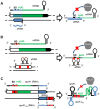Emerging functions for the Staphylococcus aureus RNome
- PMID: 24348246
- PMCID: PMC3861533
- DOI: 10.1371/journal.ppat.1003767
Emerging functions for the Staphylococcus aureus RNome
Abstract
Staphylococcus aureus is a leading pathogen for animals and humans, not only being one of the most frequently isolated bacteria in hospital-associated infections but also causing diseases in the community. To coordinate the expression of its numerous virulence genes for growth and survival, S. aureus uses various signalling pathways that include two-component regulatory systems, transcription factors, and also around 250 regulatory RNAs. Biological roles have only been determined for a handful of these sRNAs, including cis, trans, and cis-trans acting RNAs, some internally encoding small, functional peptides and others possessing dual or multiple functions. Here we put forward an inventory of these fascinating sRNAs; the proteins involved in their activities; and those involved in stress response, metabolisms, and virulence.
Conflict of interest statement
The authors have declared that no competing interests exist.
Figures




References
Publication types
MeSH terms
Substances
LinkOut - more resources
Full Text Sources
Other Literature Sources

